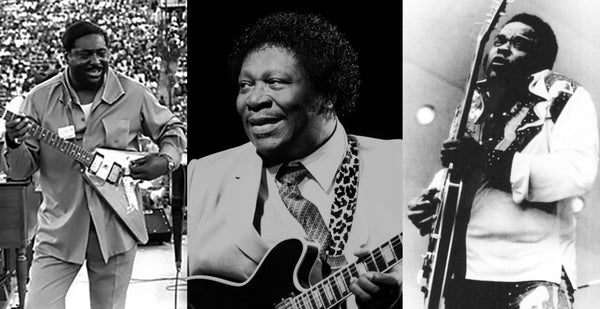Undoubtedly the three of the most influential guitarists of the Blues genre, the ‘Magi’ of Albert, BB and Freddie King shaped the sound of post war American music like few others. The musical influence of this triumvirate is palpable in musicians of the calibre of Eric Clapton, Jeff Beck, Duane Allman, Peter Green, Johnny Winter, Jimmie and Stevie Ray Vaughan, Robert Cray, Gary Moore, Joe Bonamassa, Gary Clark Jnr, John Mayer, and so many more. The Three Kings were also lucky insofar as they did at least get to enjoy a measure of success when their music crossed over from the segregated milieu of the US rhythm and blues charts to a mainstream rock audience in the sixties and into the seventies onwards.
ALBERT KING
Albert King is a massive influence on the art of the Blues Guitar in particular and rock guitar music in general. One of the genre’s great left-handed players, his signature Flying ‘V’ guitar was strung as per a right-handed model, so he effectively was playing upside down. Albert cut an imposing figure onstage, standing over six feet four in height, bespectacled and more often than not, puffing on a pipe.
Albert King was born Albert Nelson on April 25th 1923 in Indianola, Mississippi – same locale as BB King – and was one of thirteen children. The family relocated to Osceola, Arkansas, circa 1931, where King grew up picking cotton in the plantations in those environs. He encountered music initially through his guitar-playing father Will Nelson and attending church. His family also had music in their home through records by the likes of Blind Lemon Jefferson, Elmore James, Son House and others, and by dint of playing on home-made ‘diddley bow’ one-string instruments and guitars crudely fashioned from cigar boxes, Albert inched towards an approximation of a playing style. He didn’t acquire his first real guitar until 1942. Like many other aspirant musicians, King supplemented his meagre performing earnings by working a number of jobs, working construction, and also moved from city to city looking for a break. Moving to St Louis and then Gary, Indiana, he had the opportunity to play with the likes of John Brim and Jimmy Reed. He also spent some time in Chicago, and made some early recordings for the Parrot record label. By 1956, however, King was back in St Louis, which had a healthy Blues scene.
Finally finding a more settled environment, King earned a strong reputation as a performer, and cut some important recordings for the Bobbin and King labels. In 1961, his Don’t Throw Your Love On Me So Strong made the US National R&B charts, and his notoriety spread through the Midwest. By 1966, King had relocated again, to Memphis, and signed with the Stax Records label. It was here that he would cut such intense and essential blues sides as Born Under A Bad Sign, The Hunter (later covered by Free), Laundromat Blues, and his definitive takes of Crosscut Saw and Killing Floor. Born Under A Bad Sign became a stage staple for the British Rock Supergroup, Cream, whose guitarist, Eric Clapton, would later admit that the main guitar riff of his song Layla was take directly from King’s As The Years Go Passing By. Stax’s distribution – in the USA via Warner / Atlantic – meant that his albums were more easy to obtain, and his reputation amongst burgeoning white rock guitarists grew incrementally.
Albert King was a guitarist whose style was not about a speedy flourish of notes; it was all about a sulphurous, smouldering tone and feel. Playing guitar left handed, upside down, led to his using a variation on standard guitar tunings, meaning that he could execute incredible string bends which only added to the drama of his recordings and performances. He was also a musician who was open to co-opting soul and funk styles into his sound; as the sixties moved into the seventies, he cut some fabulous sinuous funk and soul – his I’ll Play The Blues For You is an utter classic, for example – and he also had a penchant for schmaltz balladry, too.
After the demise of the Stax label in the mid-seventies, King moved on to record for a variety of labels, although by the mid-eighties he had pretty much retired as a recording artist. He still performed live, however, playing good pay dates at festivals and European and Stateside tours, as well as making appearances on the Gary Moore hit album, Still Got The Blues (a pretty good version of King’s Oh Pretty Woman). Emergent players like Stevie Ray Vaughan and Robert Cray all acknowledged King’s influence. Albert King passed away in Memphis on December 19th, 1992 from a heart attack.
FREDDIE KING
Freddie King was a magisterial influence on the Hip Young British Guitar slingers of the 1960s – apart from Eric Clapton, the likes of Jeff Beck, Peter Green and Mick Taylor amongst many others acknowledged King’s attacking style as an inspiration. His untimely death in December, 1976 – at the age of only forty-two – drew to a close the career of a mercurial, intensely likable and richly-gifted musician. That his contribution to the Blues genre is still venerated, and his playing skills still celebrated, almost a half-century on from his passing, says much for the man and his music.
King took up playing acoustic guitar as a child, being taught the basics of the instrument by his mother and an uncle. His style involved using thumb and finger picks, and as such he was influenced by the Texan Country Blues hero Lightnin’ Hopkins. When his family made the time-honoured trip North to settle in Chicago, as a sixteen-year old in 1950, he hung out in the city’s thriving Blues clubs, enjoying and soaking up the sounds of the likes of Muddy Waters, Jimmy Rogers, Robert Junior Lockwood, Little Walter and Eddie Taylor. In short order, King put together his own combo, the Every Hour Blues Boys, and began performing himself.
King’s reputation grew, and his guitar skills were put to use on sessions for labels such as Parrot and Chess, but his real breakthrough came when label boss Sonny Thompson signed him to the Federal subsidiary of the King Records (Cincinnati) label. His debut single, You’ve Got to Love Her With Feeling was released in August, 1960, but it was his next 45, I Love The Woman, which featured on the flipside the vibrant, infectious instrumental Hide Away (subsequent Freddie King singles would then follow the vocal ‘A’ side and instrumental ‘B’ side format) that provided him with his breakthrough hit record, peaking at number five in the Billboard magazine R&B charts, and number twenty-nine of the mainstream Pop charts. The single made its way around the world – in 1963, Eric Clapton was introduced to the tune by his band mate in The Roosters, Tom McGuinness. Clapton would go on to cut his own version as part of John Mayall’s Bluesbreakers on the legendary ‘Beano’ album three years later.
Hideaway was named after a night club on Chicago’s West Side, Mel’s Hideaway Lounge, and was adapted from a Hound Dog Taylor instrumental. King consolidated his new-found chart status with hits such as Lonesome Whistle Blues, the choppy instrumental San-Ho-Zay, and others such as I’m Tore Down, and See See Baby, as well as notching up a Seasonal hit with Christmas Tears. King’s recorded output – especially the instrumental workouts – such as the likes of Side Tracked, which swings like a demon, were much coveted by guitar students world-wide.
That was to be the limit of Freddie’s chart tenure, however, although he continued to release some fine records for the label. One of his final sessions with the King label came with the superb Lonnie ‘Memphis’ Mack on rhythm guitar duties. Mack later quoted one of the King label executives, Syd Nathan, who opined that “...of all the King brothers (by which he meant BB, Albert, and Freddie), he thought Freddie was the most original – I have to agree with him on that, in that he wasn’t real, real Bluesy. He had some rock and roll in there. He was doing pretty much the same stuff I was doing, which was combining rock and roll with The Blues.”
BB KING
The story has been told that, in the wake of The Beatles led ‘British Invasion’ of the mid-sixties, the likes of The Rolling Stones, The Yardbirds, Them (featuring a young Van Morrison, of course), The Animals and The Kinks, to name but a few effectively took musical ‘coals to Newcastle’ by performing material to largely young, white US audiences that said audience would not be familiar with, owing to the heavily racially segregated mainstream entertainment world of North America at the time.
In terms of how the black audiences of the USA at the time regarded The Blues, it was arguably viewed as something of an anachronism; contemporary Black music of the late sixties was more focused on the Southern Soul of the Atlantic Records / Stax – Volt stable of acts, with occasional crossing over of rhythm and blues chart hits from other locales making it into the pop chart mainstream. Of course, Tamla Motown had successfully parlayed black pop to an international audience for many years. By the late sixties, the likes of the multi-racial Sly & The Family Stone had injected funk into the pop charts. Artists such as Curtis Mayfield were articulating the Social and Societal concerns of the time. But The Blues? Well, to some, it was the sound of the cotton sack and share-cropping, of the past. It wasn’t the sound of the aspirational young Black audiences of the era, or of the militant black consciousness of the time.
By the late sixties however, the emergence of an American counter culture was to unexpectedly prove fruitful for the Old School Blues acts. On Sunday, February 26th, 1967, BB King performed at the Fillmore West venue in San Francisco. He played there many times before, to a predominantly black crowd; there was something different about it this time. The kids hanging out at the place when they arrived had long hair.
B.B. walked out onto the stage as the auditorium’s floodlights captured a sea of kids rising to their feet and is suddenly hit by the size of the audience. At this point in his career he was mainly playing small club dates, with around 200 to 250 people in attendance. The Fillmore Auditorium holds more than a 1,000 souls.
King’s stock with the burgeoning counter-cultural audience was cemented with that show, and he would go on to perform for Bill Graham numerous times. He would open for The Rolling Stones on their 1969 US comeback tour. However, he was also seasoned enough to know that his loyal, hard core black audience were still out there, too, and that there was no way in which he would abandon them now that the hippie crowd had turned on to him. If James Brown was the self-styled “Hardest working man in show business”, then BB King wasn’t far behind. Although King had a notional residence in Las Vegas, he once said that home was “anyplace I stay three days”.
BB King went on to enjoy a long, long career. His tenure with the MCA Records label in the seventies would yield some notably big-selling album projects, and he was still working live and recording up to his death, aged eighty-nine, on May 14, 2015. He had played the Glastonbury Festival in 2011, and that same year had played a sell-out show at London’s Albert Hall.
With thanks to Alan Robinson

